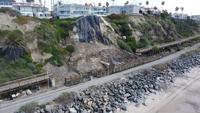Full passenger rail service through San Clemente is anticipated to resume on Monday, March 25, with the conclusion of construction on a roughly 200-foot-long catchment wall occurring at the end of the week, according to the Orange County Transportation Authority.
The agency announced on Tuesday, March 19, that both Metrolink and the Los Angeles-San Diego-San Luis Obispo Rail Corridor Agency, which operates the Pacific Surfliner, plan to restart full service on Monday morning. OCTA and Metrolink have worked together to build the emergency wall following a Jan. 24 landslide at the Mariposa Pedestrian Beach Trail Bridge, which prompted the removal of two bridge sections and delivered debris onto the railroad right-of-way.
Later that Tuesday night, the San Clemente City Council reviewed a draft Coastal Strategic Plan, a compilation of all coastal programs and projects the city is currently implementing or expected to implement in the near future, at its meeting.
Leslea Meyerhoff, the city’s contracted Coastal Administrator, told the council that staff has recognized the need to generate revenue to fund such projects and recommends the establishment of a coastal Capital Improvement Program for the upcoming fiscal year. The coastal CIP would serve as an account to deposit all funds for coastal projects.
“We’re really focused at project implementation with this strategic plan,” Meyerhoff said.
The Coastal Strategic Plan features both capital projects and initiatives categorized as planning efforts and technical analyses. The San Clemente Shoreline Project, the San Diego Association of Governments’ Regional Beach Sand III Project, the city’s Nature Based Coastal Project Feasibility Study, and the city’s pursuit of a Sand Compatibility and Opportunistic Use Program (SCOUP) are included in the list of capital projects.
Non-capital projects include the annual shoreline monitoring program, the investigation of offshore sand sources and regional collaboration efforts in South Orange County and throughout the Oceanside Littoral Cell.
The draft plan was intended to inform San Clemente residents of the city’s efforts to protect the coastline and obtain community input on advancing sand replenishment and retention projects, according to the document.
“In summary, the range of funding needed in the City to develop and sustain these programs in the next 50 years is currently estimated at ($170 million to $200 million), with a target annual revenue need of $4 million,” the agenda report read.
Sarah Schneider, organizer of the Southwest San Clemente Alliance, told the council she surveyed group members in the latest newsletter about funding options and received positive results. From a sample size of a group of 300 people, 95% of survey respondents would support a 1% increase in local sales tax that would be targeted toward paying for sand projects.
Such an increase would generate $13 million in revenue annually, according to city staff.
Additionally, North Beach Community Association leaders Christopher Butler and Ken Poczekaj indicated support for a sales-tax increase and said they felt other residents would be interested as well.
“I’m never actually a fan of increased taxes, never in my whole life,” Poczekaj told San Clemente Times. “But if you can make it a tax that’s specific, that can be controlled and that you can see (the value of) directly in front of you, I accept it, and I think other people will, too.”
Meyerhoff’s introduction of the Coastal Strategic Plan came days after the OCTA Board of Directors heard a $200 million proposal to build a large wall and place riprap up and down the San Clemente coastline to protect OCTA’s railroad.
In light of the proposal, Mayor Victor Cabral said at Tuesday’s meeting that the city met with OCTA and informed the organization there needed to be better communication and more advance notice between the two parties.
Cabral told residents now was the time for them to tell OCTA that San Clemente prefers a nature-based solution.
“We do have tools … to stop some of (their actions) if they’re going to do it unilaterally, and I think those are the kind of things we have to consider,” he said. “But we have to do it in a measured way, I believe, and with dialogue with them.”
Councilmember Rick Loeffler broached the subject of adopting an ordinance to prohibit projects that would compromise San Clemente beaches, to which City Manager Andy Hall said city staff have discussed the possibility of ensuring all coastal armoring projects must come with a form of sand replenishment.
“I think we should pass an ordinance that at least makes people recognize that when you come to San Clemente, if armoring is required, then you’ve got to be able to protect that armoring with sand on the beach,” Hall added.
Staff will bring an item forward for the council’s consideration by the next meeting on April 16, Hall said, or the following meeting.


